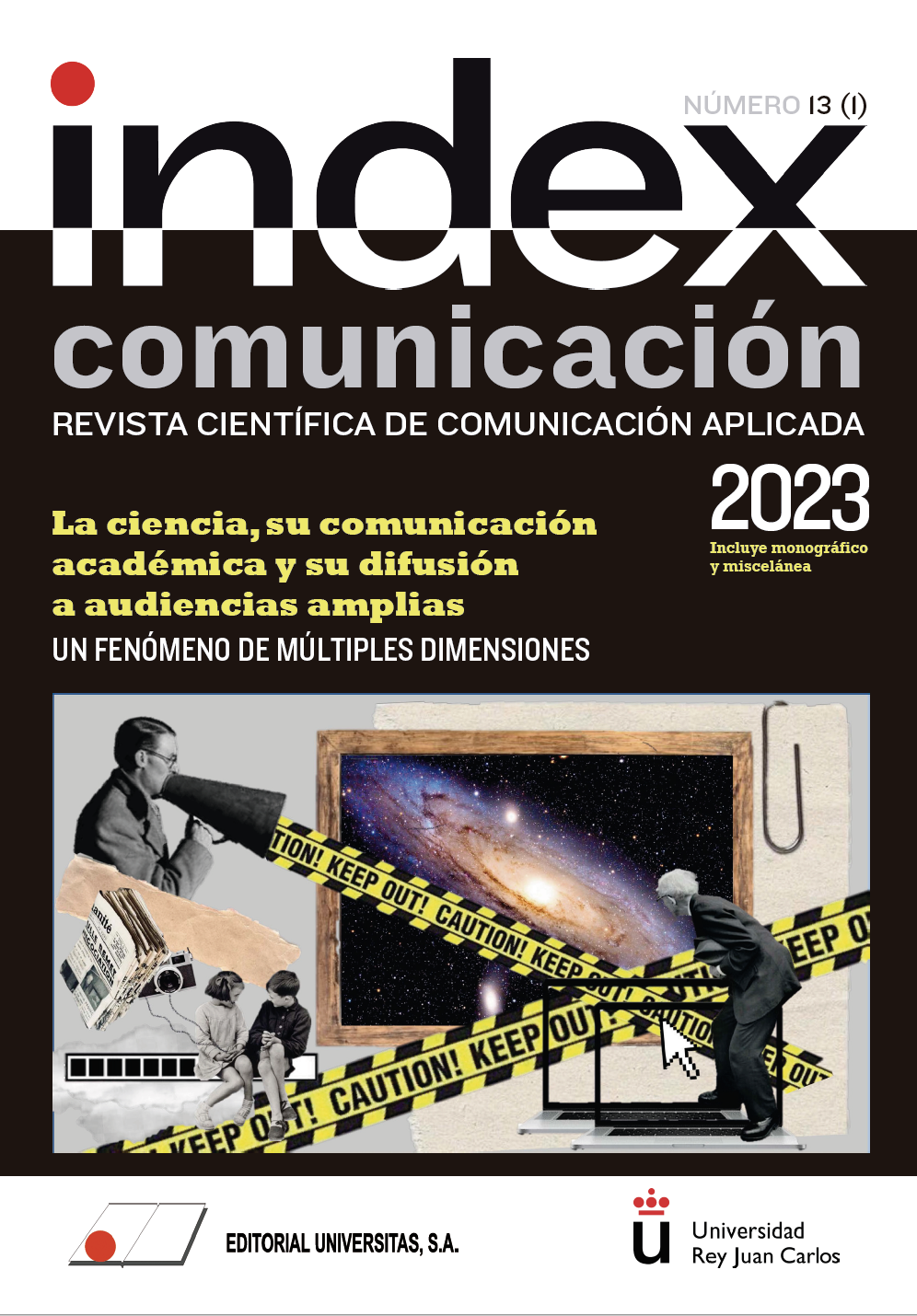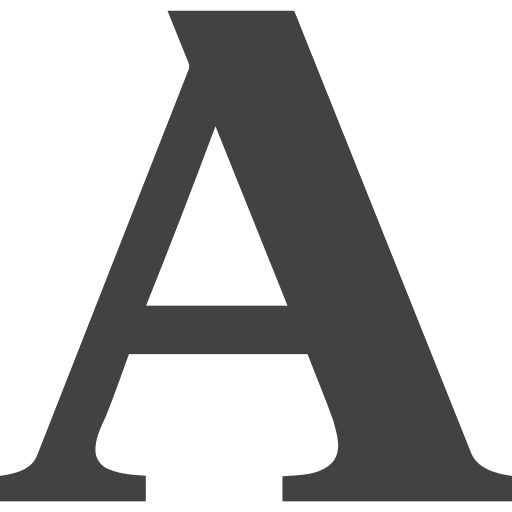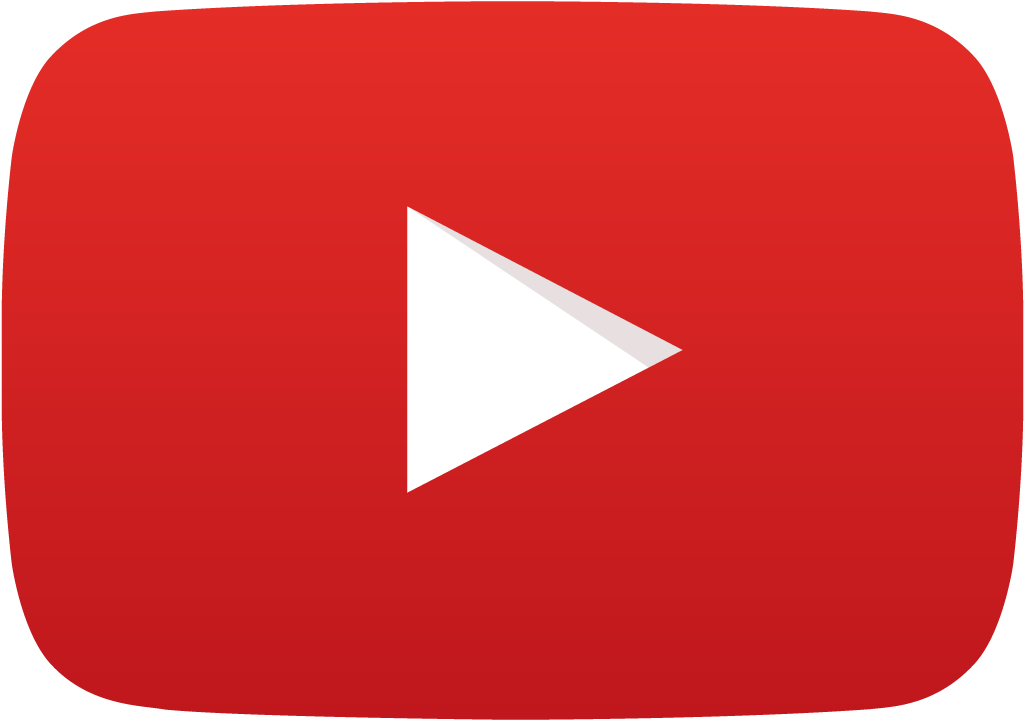Comunicación académica y buscadores científicos: 'Scoping Review'
DOI:
https://doi.org/10.33732/ixc/13/01Comun2Palabras clave:
Comunicación académica, buscadores académicos, investigación, producción científica, citas, bibliometríaResumen
El desarrollo científico necesita comunicar la investigación. La comunicación académica ha evolucionado debido a diferentes presiones, pero también ha quedado afectada por los sistemas de las bases de datos y otros sistemas de información. Esta scoping review lleva a cabo un análisis de cómo percibe la academia la influencia de bases de datos como Web of Science y Scopus, que se basan en sus propias colecciones de revistas, y otras bases de datos basadas en la búsqueda web de citas como Google Scholar, Dimensions y The Lens. Se realizó una búsqueda bibliográfica en las bases de datos Lista, WoS y Scopus sobre artículos científicos que mencionaran la comunicación académica y se centrasen en los recursos analizados. Se limitó la búsqueda a los años 2016-2021 y a los idiomas español, inglés, catalán, francés, italiano y portugués. Las bases de datos bibliográficas como WoS y Scopus siguen dando una imagen sesgada de la influencia de las investigaciones, y otras herramien-tas, como GS y Dimensions, son recursos que todavía presentan claroscuros por no permitir la réplica de las búsquedas o la descarga de los datos, como GS, por ejemplo. Por esto se recomienda a los investigadores el uso combinado de diferentes sistemas de información.
Métricas
Citas
ABADAL, E. (Ed.). (2017). Revistas científicas. Situación actual y retos de futuro. Ernest Abadal (ed.). Publicacions i Edicions de la Universitat de Barcelona.
ADIE, E. & ROE, W. (2013). Altmetric: enriching scholarly content with article-level discussion and metrics. Learned Publishing, 26(1), 11-17. https://doi.org/10.1087/20130103
AGUILLO, I. (2009). Measuring the institution’s footprint in the web. Library Hi Tech, 27(4), 540-556. https://doi.org/10.1108/073788309
AGUILLO, I.F. (2015). La Declaración de San Francisco (DORA) y la mala bibliometría. Anuario ThinkEPI, 9(0), 183. https://doi.org/10.3145/thinkepi.2015.43
ALMIND, T.C. & INGWERSEN, P. (1997). Informetric analyses on the world wide web: methodological approaches to ‘webometrics’. Journal of Documentation, 53(4), 404-426. https://doi.org/10.1108/EUM0000000007205
ANDERSON, R. (2020). Scholarly Communication. In Scholarly Communication. Oxford University Press. https://doi.org/10.1093/wentk/9780190639440.001.0001
BAIGET, T. & De MOYA ANEGÓN, F. (2020). Manual SCImago de revistas científicas.
BAR-ILAN, J.; HAUSTEIN, S.; PETERS, I.; PRIEM, J.; SHEMA, H. & TERLIESNER, J. (2012). Beyond citations: Scholars’ visibility on the social Web.
BAR-ILAN, J. & PERITZ, B.C. (2001). Informetric theories and methods for exploring the internet: An analytical survey of recent research literature. Library Trends, 50(3), 371-392.
BORKU UYSAL, B.; ISLAMOGLU, M.S.; KOC, S.; KARADAG, M. & DOKUR, M. (2021). Most notable 100 articles of COVID-19: an Altmetric study based on bibliometric analysis. Irish Journal of Medical Science, 190(4), 1335-1341. https://doi.org/10.1007/s11845-020-02460-8
BORREGO, Á. (2020). Measuring the impact of digital heritage collections using google scholar. Information Technology and Libraries, 39(2). https://doi.org/10.6017/ITAL.V39I2.12053
BURGHARDT, K.J.; HOWLETT, B.H.; KHOURY, A.S.; FERN, S.M. & BURGHARDT, P.R. (2020). Three commonly utilized scholarly databases and a social network site provide different, but related, metrics of pharmacy faculty publication. Publications, 8(2). https://doi.org/10.3390/PUBLICATIONS8020018
CHI, P.-S.; GORRAIZ, J. & GLÄNZEL, W. (2019). Comparing capture, usage and citation indicators: an altmetric analysis of journal papers in chemistry disciplines. Scientometrics, 120(3), 1461-1473.
CHUBIN, D. & GARFIELD, E. (1980). Is citation analysis a legitimate evaluation tool? Scientometrics, 2(1), 91-94. https://doi.org/10.1007/BF02016602
CONDIT FAGAN, J. (2017). An Evidence-Based Review of Academic Web Search Engines, 2014-2016: Implications for Librarians’ Practice and Research Agenda. Information Technology & Libraries, 36(2), 7-47.
CRONIN, B. (2001). Bibliometrics and beyond: some thoughts on web-based citation analysis. Journal of Information Science, 27(1), 1-7. https://doi.org/10.1177/016555150102700101
DELGADO LÓPEZ-CÓZAR, E.; ORDUÑA-MALEA, E. & MARTÍN-MARTÍN, A. (2019). Google Scholar as a Data Source for Research Assessment. In Handbook of Science and Technology Indicators (pp. 95-127). https://doi.org/10.1007/978-3-030-02511-3_4
DIMENSIONS. (2019). Journal of the Canadian Health Libraries Association / Journal de l’Association Des Bibliothèques de La Santé Du Canada, 40(1), 23-26. https://doi.org/10.29173/jchla29405
DORA. (2018). San Francisco Declaration on Research Assessment. https://sfdora.org/read/
FECYT. (2018). Scopus. https://www.fecyt.es/es/recurso/scopus
GARCOVICH, D.; ZHOU WU, A.; SÁNCHEZ SÚCAR, A.-M. & ADOBES MARTIN, M. (2020). The online attention to orthodontic research: an Altmetric analysis of the orthodontic journals indexed in the journal citation reports from 2014 to 2018. Progress in Orthodontics, 21(1). https://doi.org/10.1186/s40510-020-00332-6
GONZÁLEZ-PARDO, R.; REPISO, R. & ARROYAVE-CABRERA, J. (2020). Revistas iberoamericanas de comunicación a través de las bases de datos Latindex, Dialnet, DOAJ, Scopus, AHCI, SSCI, REDIB, MIAR, ESCI y Google Scholar Metrics. Revista Española de Documentación Científica, 43(4), 1-16. https://doi.org/10.0.15.149/redc.2020.4.1732
GOOGLE SCHOLAR. (n.d.). About Google Scholar. Retrieved 28 April 2022, from https://scholar.google.com/intl/en-US/scholar/about.html
GRANT, M.J. & BOOTH, A. (2009). A typology of reviews: an analysis of 14 review types and associated methodologies. Health Information & Libraries Journal, 26(2), 91-108. https://doi.org/10.1111/J.1471-1842.2009.00848.X
GUALLAR, J.; LÓPEZ-ROBLES, J.-R.; ABADAL, E.; GAMBOA ROSALES, N.-K. & COBO, M.-J. (2020). Revistas españolas de Documentación en Web of Science: análisis bibliométrico y evolución temática de 2015 a 2019. El Profesional de La Informacion, 29(6), 1-27. https://doi.org/10.0.12.73/epi.2020.nov.06
HARZING, A.-W. (2019). Two new kids on the block: How do Crossref and Dimensions compare with Google Scholar, Microsoft Academic, Scopus and the Web of Science? Scientometrics, 1-9. https://doi.org/10.1007/s11192-019-03114-y
HICKS, D.; WOUTERS, P.; WALTMAN, L.; RIJCKE, S. & RAFOLS, I. (2015). El Manifiesto de Leiden sobre indicadores de investigación. CTS: Revista Iberoamericana de Ciencia, Tecnología y Sociedad, 10(29), 275-280.
LAMBA, M.; KASHYAP, N. & MARGAM, M. (2020). Research evaluation of computer science publications using Altmetrics: a cohort study of Indian Central Universities. Global Knowledge, Memory and Communication, 70(4-5), 459-486. https://doi.org/10.1108/GKMC-07-2020-0097
LARIVIÈRE, V., & SUGIMOTO, C.R. (2019). The journal impact factor: A brief history, critique, and discussion of adverse effects. Springer Handbooks, 2018, 3-24. https://doi.org/10.1007/978-3-030-02511-3_1
MARTÍN-MARTÍN, A.; ORDUNA-MALEA, E.; AYLLÓN, J. & DELGADO LÓPEZ-CÓZAR, E. (2016). Back to the past: on the shoulders of an academic search engine giant. In Scientometrics (Vol. 107, Issue 3, pp. 1477-1487).
MINGERS, J. & MEYER, M. (2017). Normalizing Google Scholar data for use in research evaluation. Scientometrics, 112(2), 1111-1121. https://doi.org/10.1007/s11192-017-2415-x
OLMEDA-GÓMEZ, C. & PERIANES-RODRÍGUEZ, A. (2019). Altmetría como especialidad de investigación (Dimensions, 2005-2018). El Profesional de La Información, 28(6). https://doi.org/10.3145/epi.2019.nov.08
ORDUÑA-MALEA, E.; MARTÍN-MARTÍN, A. & DELGADO-LÓPEZ-CÓZAR, E. (2016). La bibliometría que viene: ALMetrics (Author Level Metrics) y las múltiples caras del impacto de un autor. El Profesional de La Información, 25(3), 485-496.
ROVIRA, C.; CODINA, L. & LOPEZOSA, C. (2021). Language Bias in the Google Scholar Ranking Algorithm. Future Internet, 13(2), 31. https://doi.org/10.3390/fi13020031
ROVIRA, C.; GUERRERO-SOLÉ, F. & CODINA, L. (2018). Las citas recibidas como principal factor de posicionamiento SEO en la ordenación de resultados de Google Scholar. El Profesional de La Información, 27(3), 559. https://doi.org/10.3145/epi.2018.may.09
SINGH, P.; PIRYANI, R.; SINGH, V.K. & PINTO, D. (2020). Revisiting subject classification in academic databases: A comparison of the classification accuracy of Web of Science, Scopus and Dimensions. Journal of Intelligent & Fuzzy Systems, 39(2), 2471-2476. https://doi.org/10.3233/JIFS-179906
SUN, Y. & XIA, B. (2016). The scholarly communication of economic knowledge: a citation analysis of Google Scholar. Scientometrics, 109(3), 1965-1978.
TSAY, M.; TSENG, Y. & WU, T. (2019). Comprehensiveness and uniqueness of commercial databases and open access systems. Scientometrics, 121(3), 1323-1338.
VAN RAAN, A. (2019). Measuring Science: Basic Principles and Application of Advanced Bibliometrics. In Springer Handbooks (pp. 237-280). Springer, Cham. https://doi.org/10.1007/978-3-030-02511-3_10
VKKM, H. & AZEEZ, A. (2021). Impact of Scholarly Articles on Social media: An Altmetric Mapping of University of Calicut, Kerala-India. Library Philosophy and Practice, 2021(April), 1-19.
WILDER, E.I. & WALTERS, W.H. (2021). Using conventional bibliographic databases for social science research: Web of science and scopus are not the only options. Scholarly Assessment Reports, 3(1). https://doi.org/10.29024/SAR.36/METRICS/
YANG, S.; ZHENG, M.; YU, Y. & WOLFRAM, D. (2021). Are Altmetric.com scores effective for research impact evaluation in the social sciences and humanities? Journal of Informetrics, 15(1), 101120. https://doi.org/10.1016/j.joi.2020.101120
Publicado
Cómo citar
Número
Sección
Licencia
Derechos de autor 2022 Elena Pastor Ramon

Esta obra está bajo una licencia internacional Creative Commons Atribución-NoComercial 4.0.
Los autores que publican en esta revista están de acuerdo con los siguientes términos:
Los autores conservan los derechos de autor y garantizan a la revista el derecho de ser la primera publicación del trabajo al igual que licenciado bajo una Licencia Creative Commons Atribución-NoComercial 4.0 Internacional que permite a otros compartir el trabajo con un reconocimiento de la autoría del trabajo y la publicación inicial en esta revista, sin finalidad comercial.
Los autores pueden establecer por separado acuerdos adicionales para la distribución no exclusiva de la versión de la obra publicada en la revista (por ejemplo, situarlo en un repositorio institucional o publicarlo en un libro), con un reconocimiento de su publicación inicial en esta revista.
Se permite y se anima a los autores a difundir sus trabajos electrónicamente (por ejemplo, en repositorios institucionales o en su propio sitio web) antes y durante el proceso de envío, ya que puede dar lugar a intercambios productivos, así como a una citación más temprana y mayor de los trabajos publicados (Véase The Effect of Open Access) (en inglés).















